Why there is a sewer smell in the bathroom and how it can be eliminated
Smells play an important role in our lives. Even the impression a house makes on a person is called its atmosphere.Housewives try their best to make it pleasant: they clean, take care of ventilation, use air fresheners.
If the smell of sewage appears in the bathroom, it quickly spreads throughout the house and literally poisons life. Let's figure out how to deal with this.
The content of the article:
Sewer stench is dangerous
The sewer smell is impossible to get used to. Volatile gases coming from the siphon and pipes spread throughout all areas of the house or apartment. This stench is disgusting and spoils the mood. When guests arrive, the owners of the “fragrant” home have to apologize and make excuses.
Psychological discomfort is far from the worst thing that sewer stench brings with it. What is much worse is that it is dangerous to health. The ability to separate odors into pleasant and unpleasant is a biological mechanism that has ensured the survival of humanity for thousands of years. If the aroma seems unpleasant, it means it is potentially dangerous.
The air from the sewer system is “flavored” with ammonia and hydrogen sulfide. It also contains methane, which has no distinct odor. Volatile gases affect the state of the human nervous system. There may be a feeling of causeless anxiety, nervousness, and irritability.
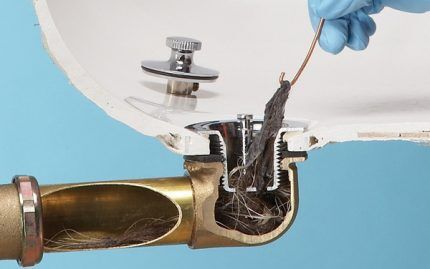
In a house that smells like sewer, people can become mopey, have breakdowns, have trouble sleeping, and even faint. Long-term exposure to hydrogen sulfide can lead to respiratory diseases: rhinitis, bronchitis.
With a high concentration of gas in the air, poisoning is possible, the symptoms of which are nausea, vomiting, headache, decreased blood pressure and dizziness.
Ammonia negatively affects vision, the respiratory system, causes a state of excitement, and has a general toxic effect. And methane can cause oxygen starvation of cells. Some disturbances in the functioning of the autonomic nervous system cannot be ruled out. For example, a “twitching eye” may well indicate long-term exposure to methane on the body.
At the first sign of a sewer smell in the bathroom or toilet, you should immediately begin to find the cause of the stench and eliminate it. Otherwise, the concentration of gases in the air will only increase, and this can lead to negative consequences for the health of the residents of the house.
Causes of odor in the bathroom
To better understand how air from the sewer enters the room, you need to have at least a general understanding of installation of a drainage system. It consists of a riser into which drains from all apartments or plumbing fixtures in the house, pipes, and plumbing fixtures with siphons are drained.
It is the water seal formed by the siphon that should prevent air from entering the bathroom from the sewer. There is always water in the bends of the device. If the water is from water seal partially or completely disappears, this causes the appearance of odor.
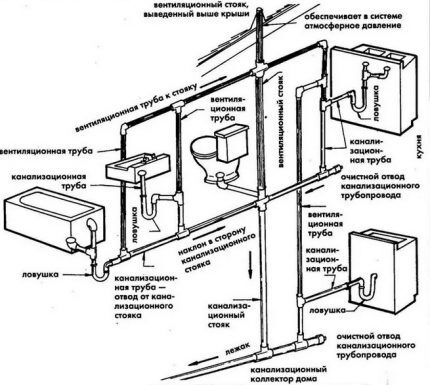
Wastewater enters the riser by gravity due to the difference in levels at which the sewer pipes are located. For normal operation of the riser, air must flow from above, so the upper part of the riser goes into the fan pipe, which provides ventilation.
If fan pipe improperly installed or clogged, then air begins to flow into the sewer through weak seams and joints of the pipeline or through siphons.In the second case, the water seal partially or completely disappears, because he is sucked into the sewer system.
The lower the siphon is placed, the more likely it is that this will happen, and the lowest level of the siphon is located near the bathtub.

There are several main reasons why there is an unpleasant odor in the bathroom:
- Errors in the design or installation of sewerage. If the system is assembled incorrectly, a constant stench is guaranteed. Air fresheners and household chemicals will not solve the problem. You will have to spend money: you need to redo the system, and this should be done by qualified craftsmen.
- Incorrect angle of sewer pipes. If the angle is too small, wastewater stagnates in the system and a rotting smell appears. A radical solution to the problem is also expensive: you need to rebuild the pipeline. You can get by with half measures - change the sealing gaskets and carefully seal the joints.
- Problems with the siphon. If the pressure in the sewerage system is higher than atmospheric pressure, air in the form of bubbles can escape through the siphon into the room. The reason is that the pipes are filled with waste. This is possible due to insufficient pipe diameter (errors in calculations when designing the system), blockages or icing.
- Leaks. Water from the sewer can seep through leaky pipe joints. If the leak is large, it can be easily detected by the puddles on the floor. If it’s small, it’s more difficult, because The water evaporates quickly and does not drip, but it stinks and contributes to dampness in the room.
- Poor ventilation. To prevent air from stagnating, a ventilation system is installed. It can be natural or forced. If the system was initially installed incorrectly or the ventilation shaft is clogged, the room will have a musty smell, dampness and fungus.
- Blockage in the pipe. The most common cause of sewer smell in the bathroom is a clog. Dirt particles, debris, sand, and hair constantly end up in the sewer. Having bunched up, threads and hair narrow the inner diameter of the pipe and trap dirt from the drains. As a result, a foul-smelling plug is formed.
If the problem arose due to errors in the installation of sewerage or ventilation, its solution should be entrusted to professionals. But you can deal with blockages, malfunctions of devices or leaks yourself. The main thing is to correctly determine the cause of the stench.
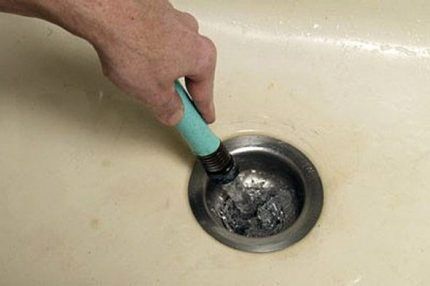
In many cases, you can easily prevent the appearance of an unpleasant odor in the bathroom and promptly fight blockages. To prevent blockages, it is enough to install special screens on the bathtub drain and sink and regularly clean them of dirt. The grate traps hair and large particles that could clog the pipe.
A common cause of negative sewer odor is mistakes made during bath siphon installation. We recommend that you familiarize yourself with the features and rules of this work; you can find them in our proposed article.
How to get rid of unpleasant odors?
First you need to determine what caused the problem. It is necessary to consistently check the operation of the ventilation and sewer systems and pipe joints.
To make sure that there is normal draft in the ventilation, apply a sheet of paper to the grille. If it sticks, everything works great. There is another simple diagnostic method: hold a lit match or lighter to the ventilation hole. The flame should deflect towards the shaft. If this does not happen, you need to do ventilation.

The next step is to check the operation of the sink and bathtub.You need to open the taps at full power and watch how quickly the water flows into the drain holes. If it's slower than usual, it's a sign of a blockage.
If the water drains normally, but the smell does not subside, it makes sense to rinse the drains with boiling water. This is more of a preventive measure, but it helps to clean and disinfect pipe walls and destroy bacteria.

If everything is in order with the ventilation and pipes, inspect and feel all the joints of the sewer system elements. There should be no cracks or chips anywhere. If you find moisture, apply a dry white cloth. A wet spot on it will help determine where exactly the water is leaking. This area will need to be sealed.
Option #1: improving ventilation draft
Natural exhaust may become less effective for several reasons:
- clogging of the ventilation shaft;
- replacing bathroom doors with thicker ones;
- powerful forced air flow from neighbors (relevant for apartment buildings).
It should be noted that in the heat of summer, ventilation is often worse than in winter, for natural reasons. Hot outside air prevents the flow of cold air masses from cool rooms, and an air lock forms. This can be easily fixed by leaving the bathroom door slightly open in the summer.

Remove the ventilation grille, take a flashlight and inspect the ventilation shaft as far as is accessible.Sometimes the clog is very close to the exhaust vent and can be removed with your hands, a hook, or a small scoop. It could be a piece of brick that has fallen off the shaft wall, a dead animal that has climbed into the ventilation, or just garbage.
If the problem arose due to a tight door or a high threshold, you can provide additional air flow from under the door leaf. The lower part of the canvas is cut so that the door does not fit tightly to the frame and a small gap remains. A more “gentle” option is to install a decorative grille on the bottom of the door.
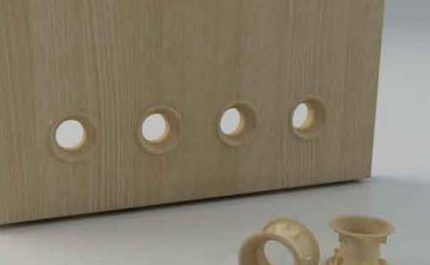
If you don’t want to experiment with doors, you can simply not close them, but cover them, leaving a small gap for air access. An excellent option is to install a fan in the exhaust vent. To prevent air from the shaft from entering the room, install either an axial fan or a duct model with a check valve.
To stimulate the outflow of dirty air into bathroom exhaust vent It is better to install an axial fan:
Option #2: cleaning pipes and siphons
There are many useful devices that you can use to clean your drains yourself. The most popular are plunger and cable. The first tool is perfect for cleaning the siphon, but it is unlikely to help if the clog is large and located far from the drain. The second one is universal.
The plunger is placed so that it completely covers the drain hole of the bathtub or sink. After this, open the water until it covers the bottom of the elastic cap, and make several forward movements up and down. Then the plunger is lifted and the water flow is observed.If it doesn't go well, the operation is repeated.
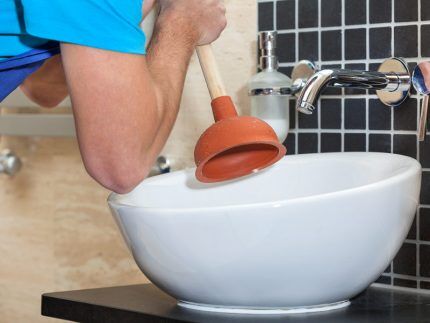
Metal cable is the “heavy artillery” for cleaning pipes. If the plumbing fixtures are plastic, it is not advisable to use it. If the pipes are metal and there is no risk of damaging the siphon, this is a reliable tool.
Rules and features cleaning drains with a rope are described in detail in our recommended article.
The cable is passed into the drain hole and begins to rotate slowly, carefully pushing it further through the pipes. When the tool reaches the blockage, the debris will catch on the hook and can be removed. After this, the drain is washed with hot water to remove any remaining plugs and dirt.
Metal cable will be in excellent condition and will last for decades if properly cared for.After use, the cable is washed, wiped dry, lubricated with machine oil, rolled up and stored in a dry place.
Sewer smell can be eliminated using available means. To do this, you can use soda and vinegar or citric acid. These substances destroy small blockages, remove deposits well from pipe walls and disinfect.
Here are some examples of how you can use them effectively:
- Soda. Pour half a pack of soda into the bathtub or sink drain and leave for 20 minutes. After this, the sewer is washed with plenty of hot water.
- Soda with vinegar. Pour soda into the drain, and then pour a glass of vinegar, close the drain with a stopper and rinse after 20 minutes.
- Lemon acid. In combination with boiling water, citric acid cleans pipes no worse than soda and vinegar. The drain should be flushed when the acid stops hissing and foaming.
Instead of homemade products, you can use ready-made chemical compositions for cleaning pipes. They are more effective, but unsafe for health, so when using you need to wear gloves and protect your skin, eyes, and respiratory organs.

The list of the best drain cleaning products includes “Mole”, “Floop”, “Tiret”, “Pothan”, “Mr. Muscle”. They can be sold in the form of liquids, gels, granules. Granular products are considered the most powerful.
If used incorrectly, they can damage plastic pipes, so you should not leave the compounds in the sewer longer than the manufacturer recommends.
You will find valuable recommendations and detailed instructions for cleaning sewer pipes In this article.
Option #3: sealing sewer joints
The easiest way is to seal the joints with foam, but a more reliable way is to treat them with a special sealant. The ranking of the most popular formulations is headed by products from the famous brands Ceresit and Tytan. Experts speak well of Moment, Ciki Fix.
There are several types of plumbing sealants:
- Silicone. These are expensive sealants, but they have good adhesion and elasticity. The compositions retain their properties at high and low temperatures and do not shrink.
- Acrylic. The main advantage of acrylic sealants is their long service life, good water-repellent properties and resistance to temperature changes. Disadvantage: low elasticity.
- Silicone-acrylic. The best choice. Sealants can be used to seal seams, repair small cracks and chips, and bond surfaces.
- Polyurethane. Paint can be applied over polyurethane compounds. This is a good option if the leak is found in a visible place and needs to be hidden. The disadvantage is a strong toxic odor, which disappears after the sealant hardens.
Before starting work, surfaces should be thoroughly cleaned, dried and degreased. The sealant is applied to the seam in a circle. The line must be continuous. For ease of application and leveling, you can use a soft spatula.
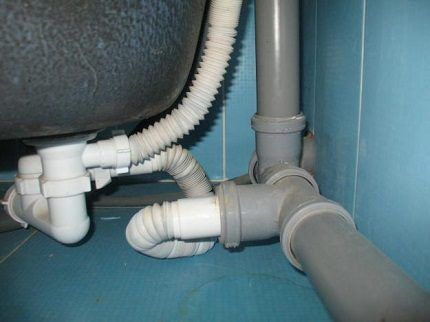
When the work is completed, the composition is left until completely dry (the time should be indicated on the packaging), after which the sewer can be used.
Conclusions and useful video on the topic
There are many ways to get rid of unpleasant odor. Here are some helpful videos to help you deal with sewer stench and prevent it from happening again.
Video #1. Helpful tips for dealing with bathroom leaks:
Video #2. Instructions for using baking soda and vinegar to clean your bathtub:
The smell of sewage in the bathroom can and should be dealt with, but it is even easier to prevent its occurrence. Install screens on the drain holes of the sink, bathtub, and shower.
Prevention doesn’t hurt either: flush the drains with soda or household chemicals once every 1-2 months. Once every six months, check the operation of the ventilation and the joints of the sewer system. This is enough to keep the air always fresh and clean.
Tell us about how you dealt with negative sewer odor. Please write comments in the block below. Here you can ask questions and post thematic photographs.




It is clear that the sewer itself needs to be cleaned and sealed. But regarding ventilation in our apartment buildings, I can say that, as a rule, they do not meet the requirements at all. The fact is that it is mainly blowing out of them, but there should be a stretching. Accordingly, you either shouldn’t rely on the ventilation itself at all, or you need to install grilles with exhaust fans.
Oleg, you have the right to submit an application to the Criminal Code to check your ventilation and if they respond, no violations are found, and an independent examination finds them, file a complaint with Rospotrebnadzor, the court or the housing inspectorate for improper performance of duties to ensure high-quality ventilation of apartment building premises.
Yes, it is blowing from the ventilation duct, so even forced ventilation (with a fan) does not help. From time to time, life is poisoned by the smell of sewerage from ventilation.
We have exactly the same problem in our house. The stench is simply incredible! They spent a long time looking for the cause, flushing the pipes and so on. There were no blockages. But it still smells! Mom decided that it was coming from the shower stall and began to plug the drain with a stopper. But this is not a solution to the problem! As a result, we reached the very drainage hole and threw a lot of antiseptic there. The smell has become much less! And my husband now monitors the sewage level. If it is too full, you need to pump it out.
Hello. To eliminate odors from the sewer system of a private home, a rather complex device called an air valve is used. True, installing it can be troublesome. It is also recommended to install check valves on autonomous septic tanks to prevent the outflow of drains into the room when the septic tank overflows.
Hello! If the drainage hole begins to fill, you need to make a second one - an overflow hole.
Thanks for the informative article!
It’s great if you can also suggest an option for action in a rented apartment. In the bathroom, the shower drain is built into the tiled floor. If you don’t use the shower for a couple of days (alternating with the bath), it starts to smell terrible. Washing with special products does not help. Ventilation is ok. Dismantling the tiles is not an option. I wouldn’t want to move out - otherwise everything is fine and the market for 4-room apartments in the desired area is very small.
Similar problem. Exactly the same. I would like to see a solution to the problem from experts.
Try pouring regular water into the drain on the floor more regularly. It sounds like your floor water seal is drying up.
For 4 months after the renovation in the bathroom, in the cabinet with pipes on the side of the sewer pipe, there is not a regular (sometimes more, sometimes less) acrid smell, similar to sealant, all organizations, starting with the management company, are kicking each other, Ventilation is working properly, help me, what should I do?
Please tell me what this could be, I often have bubbling and air comes out of the sewer pipe in the toilet, bathroom and kitchen,
I have a draft coming from my bathtub drain. I live in a 17-story mansion. Water is clearly leaking from the siphon under the bathtub. I made a request to the management company to check the ventilation of the pipes, but you shouldn’t rely on them. What do you advise? Theoretically, there is access to the pipe right in front of the riser. Can we introduce 4 pipe turns in a U shape there? Or is this a bad idea?
Added photos
The smell from the sewer appears in winter after severe frosts. During the thaw (daytime temperatures are close to 0) the smell disappears, but then after frost it appears again. From time to time I hear bubbling in the sewer. The smell in the morning is incredible. I live on the top floor of a house.
Exactly the same situation. Is there a solution? Should I contact builders or specialists?
Hello! There is a powerful stench in our bathtub because, judging by the sounds, water is being drawn out of the siphon and the water seal is disappearing, presumably when the neighbors flush the toilet. We fight blockages regularly, the ventilation works, the pipes themselves in the apartment are new, the repairs are at least a year old.How likely is it that the problem could be with the drain pipe or in the design/installation of the sewer?
Hello! Please tell me, in the morning there is a smell from the overflow in the bathroom. It's fine all day, but in the morning there's a stink. What is the reason for this and what can be done??
I cleaned everything, there are no blockages. I checked the siphon and everything is clean.
Hello! Please tell me, in the morning there is a smell from the overflow in the bathroom. It's fine all day, but in the morning there's a stink. What is the reason for this and what can be done?? A similar problem with the stench in the morning, it is impossible to enter. What could it be?
Good day!
We live in a private house, on the second floor the bathroom starts to stink after draining the hot water. In other cases there is no smell. There is also no smell on the first floor. Never. What could it be?